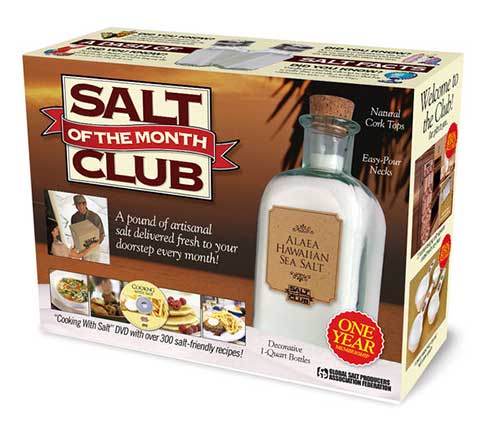Sodium Chloride? So Crazy.
Salt is an immensely valuable resource, though if you sign us up for a Salt of the Month club, we'll have to stop being friends.
0.4%
The percentage of salt in the human body, according to the BBC's Science World magazine, a level that's roughly the same as seawater. Human consumption of salt is one of those things that drives people crazy—especially healthy people. But in recent years, arguments have started to surface that the anti-salt freakout is overblown.

Send Your Enemies Salt
Back in 2006, The Onion had a hilarious idea. Rather than sell gift wrap on its official store, the website and then-newspaper decided to design and sell empty boxes of products that were fake, but just realistic enough to possibly be real. The magic behind why the strategy works is simple: The sub-"As Seen on TV"-level gear is absurd enough that you'd never believe anyone would actually want it. The company still sells these decoy boxes, but some of the early ones—the "USB Toaster," the "Visor•ganizer"—remain the best.
One of the boxes, however, turned out to be a little too real to keep around. That box, for "The Salt of the Month Club," was a nice stab in the eye of foodies who read Eat, Pray, Love a little too closely. But as it turns out, Salt of the Month clubs exist. And they're weird. Some of the more notable ones:
Salts of the 7 Seas, a company that pledges to sell salt from every corner of the globe, sells a 12-month subscription to its gourmet salt plan, which ensures that you'll get 24 different kinds of salt, including "Applewood Smoked," "Bamboo Essence," and everyone's favorite, "Cyprus Onyx." It'll only cost you $359.95.
If that price is a little high for you, there's always the slightly-more-modest offering from Etsy sellers Allspice Emporium. Based on the flavor choices—"Maple Jalapeno," "French Quarter Espresso," "Raspberry Chipotle"—you might actually be doing your frenemy a flavor by spending $150 on this.
And for those on a budget, the company Two Snooty Chefs offers up six different types of salt—including "Alaea Hawaiian Sea Salt" (which is red). and Sel Gris de Guérande (which is gray). At $70 bucks, you too can put salt in a friend's mailbox for six months.
Five salt shakers
- Here's a woman you shouldn't talk to about the Morton's disaster: Sioux Falls, South Dakota resident Arlene Lefler has a massive collection of Morton Salt Girl memorabilia. And she isn't alone.
- Humans have been using salt, to preserve meat for hundreds of years, but until the 1800s, cured meat generally had a gray color to it. You can credit saltpeter, also known as potassium nitrate, for being the first material to give cured meat a tasty red color.
- It's worth noting, by the way, that potassium nitrate is also a key material in the making of fertilizer and gunpowder.
- Negotiating your wage? Ask your boss for your weight in salt. That's what Roman soldiers did back in the day—leading the word "salary" to develop from the practice.
- Why should you have salt and lime with your tequila, anyway? Fortunately, someone researched that, though if you're drinking the good stuff, you don't really need it. (We screw up the order of the salt-Tequila-lime deal most of the time anyway!)
1877
The year a battle broke out in West Texas… over salt. The San Elizario Salt War, which was a lingering conflict over control of salt lakes at the base of the Guadalupe Mountains. The conflict, which killed a number of people, was an effort by American settlers who claimed the land, and wanted to begin collecting fees on the salt. The Mexican Americans who lived in the region previously had access to the salt for free, on an area once considered communal land; they lost.
two
The number of "salt wars" that took place in Italy during the Middle Ages. The first one, the War of Ferrara, involved a land fight over salt, among other things; the other, the 1540 Salt War, was a protest by the city of Perugia against a tax on salt levied by Pope Paul III. The latter is the root of an urban legend as to why we no longer salt our bread.

Salivating for road salt
Admit it: We're total weaklings that don't want to fall down when we walk outside, want to be able to drive our cars when there's white sludge on the ground, and need to be able to get from point A to point B. So it's understandable why we use so much road salt—it's a pretty brilliant hack, changing regular water to saltwater, taking advantage of the lower melting point.
That's cool and all, but there's a problem: it's not nearly as eco-friendly as it could be. It damages vehicles, it corrodes infrastructure, it gets in rainwater, and it's probably used a lot more than it needs to be—compounding all the other problems.
"We've become salt-addicted over the last 50 years, and we're now discovering that there are all these hidden costs," University of Washington civil and environmental engineering professor Xianming Shi told Vox recently. The problem is that alternatives to salt aren't nearly as good. Anyone have any ideas?
So, that's the deal with salt. By the way, if you have any ideas for things you'd like to read in Tedium, we're an open book. We may not get to your idea right away, but it'd be awesome if you shared it. We're in this whole end-of-the-long-tail thing together, so we might as well get used to one another. Shoot me an email or hit the reply button and tell me what's on your mind. Hopefully it's more than salt.
More stuff next week—may your weekend be full of salt, possibly in tequila form.
:format(jpeg)/2018/04/uivdxc7dduws1mw6d6c3--1-.gif)
/2018/04/uivdxc7dduws1mw6d6c3--1-.gif)

/uploads/ernie_crop.jpg)